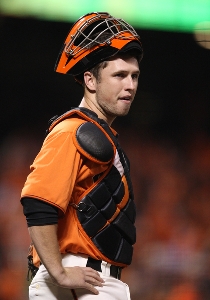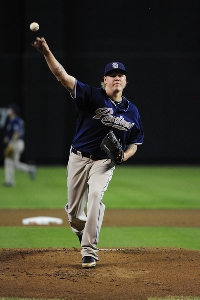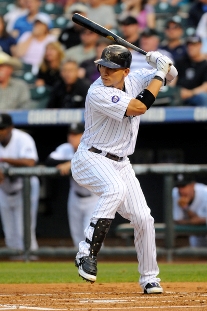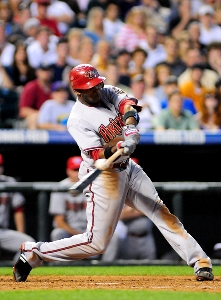The 2011 division previews begin with the NL West, home of the World Champion San Francisco Giants. I’ll use 2010 WAR from FanGraphs for the evaluation. I concentrate on the projected starting position players, the five man rotation, and the closer, using the CBSSports.com depth charts.

Buster Posey is poised to become the heart of the Giants lineup. Photo: Icon SMI.
San Francisco Giants
- Position Player WAR: 26.2
- Starting Pitcher WAR: 12.0
- Closer WAR: 2.7
- Total WAR: 40.9
Over the past few seasons, the Giants seemed to sport a great pitching staff and a weak offense. Not this year. The Giants starting eight come into the season with the highest combined WAR in 2010 of any team in the division. Part of that comes from career years from Andres Torres and Aubrey Huff. While those two likely fall a bit short of their 2010 marks, the Giants will get a full year of Buster Posey. Pablo Sandoval worked his weight off this winter and may rebound to close to his 2009 levels. They also have Brandon Belt waiting in the wings. So while I don’t think they will reach the 26.2 WAR in the way the players did in 2010, I don’t see a reason why they won’t come close to that number.
The rotation is extremely solid, with Barry Zito the worst pitcher at 1.2 WAR in 2010. If there is going to be a falloff, Madison Bumgarner is the likely candidate. His ERA was much better than his FIP, although there’s nothing wrong with a 3.66 FIP. Then again, Lincecum’s 4.0 WAR was a down year for him. He could easily make up a two WAR decline in the rest of the staff.
Brian Wilson starts the season hurt, but until it’s clear it’s a serious injury, he’s the best closer in the division. The Giants put an excellent team on the field in 2011, poised to repeat for a division title.

Mat Latos leads a young and upcoming Padres rotation. Photo: Icon SMI
San Diego Padres
- Position Player WAR: 15.4
- Starting Pitcher WAR: 7.1
- Closer WAR: 2.4
- Total WAR: 24.9
The Padres played surprisingly well in 2010 based on excellent pitching and an offense good enough to support the hurlers. Apart from Mat Latos, however, the pitching staff was not all the impressive in terms of WAR. Some of that comes from pitching in an extreme park, as PETCO dampens offense; pitching is just not as valuable there. However, most of the staff is young, and with a year of major league service under their belts I expect more progress from them than declines.
A wild card in the staff will be Aaron Harang, who saw his strikeouts fall and walks rise in 2010. He was beset with a number of minor injuries and spent time in AAA, limiting him to 22 starts. Aaron does give up more fly balls than grounders, so he should be helped by the home run killing power of PETCO.
Among the position players, Chase Headley posted the best season with a 4.6 WAR. What San Diego lacks this season is that second great player they had in Adrian Gonzalez. They lose nearly five WAR in bringing in Brad Hawpe, coming off a poor season. Hawpe was never a great players, so even if he rebounds to a career norm of about 1.5 WAR, the Padres lost a lot offensively. They tried to make it up in the middle infield, but they’ll need but Orlando Hudson and Jason Bartlett to play at their best to make that happen. Unless Cameron Maybin suddenly turns into a superstar, the Padres will fall short of their 2010 heights.

Carlos Gonzalez tries to build on his near triple crown 2010. Photo: Icon SMI
Colorado Rockies
- Position Player WAR: 19.0
- Starting Pitcher WAR: 13.9
- Closer WAR: 0.9
- Total WAR: 33.8
The Rockies are the closest team to the Giants in the division, and a big reason is the pitching. When you take the home parks into consideration, the Rockies do better than the Giants and the Dodgers. Ubaldo Jimenez posted the best season in the division of any starter in 2010, but Jhoulys Chacin and Jason Hammel came in around 3.0 WAR, too. This is a deep rotation.
On offense, the Rockies hold two big guns in Troy Tulowitzki and Carlos Gonzalez, but there’s not a lot supporting them. What’s hurting them the most is a lack of a replacement for Todd Helton. The franchise player produces a 0.4 WAR at a position where players should be cranking out a ton of offense. Instead, Colorado will hope that Chris Iannetta finally finds a hitting groove while Dexter Fowler and Seth Smith continue to improve. It will be ironic if the Rockies fail to make the playoffs again with a great pitching staff.

Matt Kemp needs to return to his big seasons of previous years to help propel the Dodgers to a title. Photo: Icon SMI
Los Angeles Dodgers
- Position Player WAR: 15.2
- Starting Pitcher WAR: 12.3
- Closer WAR: 2.2
- Total WAR: 29.7
Don Mattingly inherits a very good pitching staff, anchored by Clayton Kershaw and Chad Billingsley. In fact, you can make the argument that with Hideki Kuroda, this is the most consistent top three starters in the division. With Jon Garland hurt the fifth slot may be a little weak, but that’s pretty typical for most teams. Pitching really shouldn’t be a problem for the Dodgers.
So Mattingly, the former hitting coach, needs to bring the Dodgers bats around. Right now, they look like the worst lineup in the division. The highest WAR of the starting eight in 2010 belonged to the shortstop, Rafael Furcal at 4.1. Normally, that would be a good thing, but the Dodgers just didn’t fill in around him well. James Loney posted just a 1.1 WAR at first base as he lacks power. A poor season by Matt Kemp produced a 0.4 WAR. Loney, Kemp and Ethier are now all in their primes. It’s time for them to produce big and turn the Dodgers into winners again.

Justin Upton is a big part of the Diamondbacks young core. Photo: Icon SMI
Arizona Diamondbacks
- Position Player WAR: 20.9
- Starting Pitcher WAR: 6.3
- Closer WAR: 1.5
- Total WAR: 28.7
In 2010, the Diamondbacks core of hitters matured into a solid group of hitters. Stephen Drew, Justin Upton and Chris Young combined for a 12.5 WAR. Along with the addition of Kelly Johnson, that group formed a great core. Unfortunately, the Diamondbacks did little to complement that core. Players like Xavier Nady and Melvin Mora aren’t likely to add much. While Juan Miranda hit well at AAA, he didn’t hit great at AAA, and so far there’s little in his major league record to indicate he’ll be a typical power hitting first baseman, especially at age 28.
(What is it with this division and first basemen? Four of the five teams suffer offensively because they can’t find someone to hit like a typical first sacker.)
The problem with the Diamondbacks is pitching. There really isn’t much behind Ian Kennedy and Daniel Hudson. Joe Saunders good luck with the Angels didn’t carry over to Arizona, and the back of the rotation looks to be about replacement level. Of course, the bullpen was so bad in 2010 that they almost have to be better.
In a way it’s sad. The Diamondbacks finally got the core working, but there’s nothing there to support it. I think they let Josh Byrnes go a little too soon.
Predictions
Here’s how I see the odds of the five teams winning the division:
- San Francisco Giants 50%
- Colorado Rockies 25%
- Los Angeles Dodgers 10%
- San Diego Padres 10%
- Arizona Diamonbacks 5%
I usually don’t put a lot of stock in bullpens, but the Padres year in and year out put an excellent relief staff on the field. Even though the Diamondbacks have a better core WAR, I like the chances of San Diego better due to the bullpen and a maturing starting staff.
The Giants are the class of the division, with enough players likely to improve to cancel out those likely to decline. The Rockies can match them on pitching, but will need career years from some of their up and coming players to match the Giants on offense. The Dodgers ability to win the division depends on Don Mattingly‘s ability to get the big three to produce like stars.


I’m pretty sure that Fangraphs’ WAR for pitchers uses FIP, not ERA. So Bumgarner’s extra-low ERA wouldn’t make him a regression candidate in this type of analysis. That is, the WAR you’re using never considered his ERA to begin with.
I bring this up only as it might bear on the rest of the series. And of course, I could be wrong.
Scooter » You make a good point. However, higher ERAs could lead to fewer innings pitched, which does hurt the playing time aspect of WAR.
Pingback: I Wouldn’t Miss You if I Had Better Aim | Ducksnorts